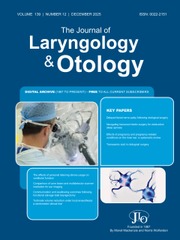No CrossRef data available.
Article contents
The use of tissue sealant in parotidectomy: a systematic review and meta-analysis
Published online by Cambridge University Press: 10 May 2022
Abstract
Drains are used post-parotidectomy to reduce seroma and haematoma formation. Tissue-derived thrombin sealant can enable a drainless procedure, allowing for an earlier discharge, less discomfort and a more cost-efficient method. This study aimed to assess whether tissue sealant improves wound-related outcomes in parotidectomy.
A systematic literature review was performed using a standardised published methodology and custom database search strategy. A fixed-effect meta-analysis of the combined complications was conducted.
Thirteen studies were identified relating to parotidectomy procedures using tissue sealants, of which nine were included in the quantitative synthesis. Our analysis suggested a reduction in the complication rates, including haematoma and seroma, with drainless parotidectomy procedures involving tissue sealant use when compared with conventional procedures with post-operative drain use.
Fibrin sealant in parotidectomy may be used to facilitate a drainless approach, expediting recovery and offering better comfort to patients.
- Type
- Main Article
- Information
- Copyright
- Copyright © The Author(s), 2022. Published by Cambridge University Press on behalf of J.L.O. (1984) LIMITED
Footnotes
Djamila Rojoa takes responsibility for the integrity of the content of the paper


